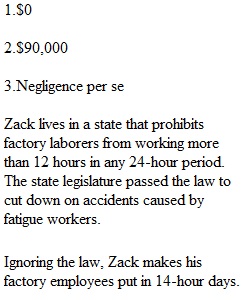


Q Question 1 2 / 2 pts Two cars, driven by Fred and Barney, collide. At trial, the jury determines that the accident was 90% Fred's fault and 10% Barney's fault. Barney's losses total $100,000. If he lives in a state that uses contributory negligence, Barney will recover ______________. Question 2 2 / 2 pts Two cars, driven by Fred and Barney, collide. At trial, the jury determines that the accident was 90% Fred's fault and 10% Barney's fault. Barney's losses total $100,000. If he lives in a state that uses comparative negligence, Barney will recover ______________. Question 3 2 / 2 pts Zack lives in a state that prohibits factory laborers from working more than 12 hours in any 24-hour period. The state legislature passed the law to cut down on accidents caused by fatigue workers. Ignoring the law, Zack makes his factory employees put in 14-hour days. Eventually, a worker at the end of a long shift makes a mistake and severely injures a coworker. The injured worker sues Zack. Which of the following legal recoveries will be most relevant to this case? Question 4 2 / 2 pts Randy works for a vending machine company. One morning, he fills up an empty vending machine that is on the third floor of an office building. Later that day, Mark buys a can of soda from that machine. He takes the full can to a nearby balcony and drops it three floors onto Carl, a coworker. Carl falls unconscious. Which of the following can be considered a factual cause of Carl's injuries. Question 5 2 / 2 pts Randy works for a vending machine company. One morning, he fills up an empty vending machine that is on the third floor of an office building. Later that day, Mark buys a can of soda from that machine. He takes the full can to a nearby balcony and drops it three floors onto Carl, a coworker. Carl falls unconscious. Which of the following can be considered a proximate cause of Carl's injuries. . Correct!
View Related Questions